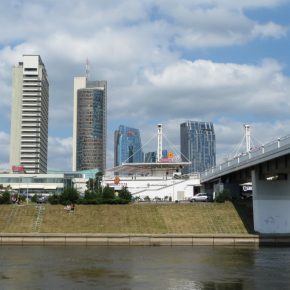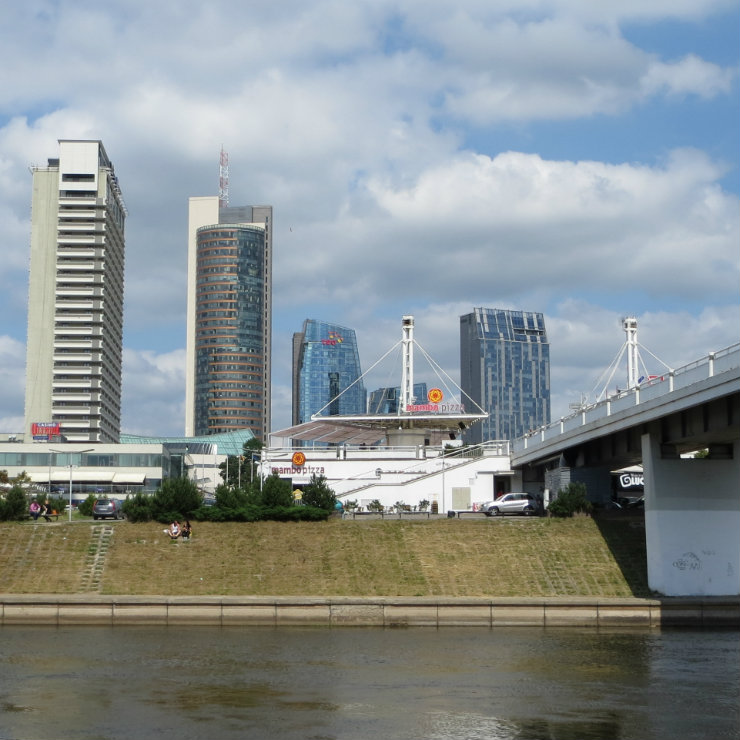
Vilnius, Lithuania (Bernt Rostad, CC BY)
According to the latest CEE Investment Report 2016: Mission to Outperform report compiled by Skanska, JLL and Dentons, in cooperation with ABSL, the highest GDP growth is expected in Lithuania (3.6 per cent), Poland (3.5 per cent), Estonia (3.4 per cent) Romania (3.3 per cent), Slovakia (3.2 per cent) and Hungary (2.1 per cent), the report notes.
CEE is one of the safest parts of the world in terms of business operational risk. The threats common to emerging economies, such as geopolitical and social risks, are not present in the region, it argues. The Czech Republic, Slovenia, Poland, Hungary and Slovakia are all ranked in the world’s 25 safest countries, according to the Institute for Economics and Peace.
“CEE, with around 100 million people and strong economic indicators, is a region with a strong focus on increasing its performance in terms of growth,” the report notes. “Developing much faster than Western Europe, it is one of the growth engines of the EU economy. Foreign direct investment (FDI) is one of CEE’s strongest growth engines. The region is experienced in advanced business services, IT and back-office operations, which are currently on the list of the most popular services for FDI in Europe.”
“Apart from favorable macroeconomic conditions, what matters to investors is the region’s well-educated, hardworking and talented labor force. Every year CEE produces 1.2 million graduates, many of them with working proficiency in 40 languages which they use on a daily basis. Poland, the Czech Republic, Slovakia and Ukraine provide the market with 285,000 engineers a year – more than the US. In the OECD’s PISA rankings, Poland, Slovenia, the Czech Republic and Latvia are all in the top 30 countries with the best math results. It is evident that people are the real power of this region. They have all the skills they need to set ambitious goals and achieve extraordinary results for their respective countries,” says Katarzyna Zawodna, President of Skanska Commercial Development Europe.
A BPO/SSC paradise
In many rankings CEE countries are ahead of BPO/SSC/ITO giants such as India. The region’s sector attracts even more companies with its geographical and cultural proximity as well as cost efficiency. One observation in the report which illustrates the increasingly strong position of the CEE business services sector is that the number of SSCs in Western Europe has declined, while the number of SSCs in Eastern Europe is on the increase. This trend is set to continue for the foreseeable future.
According to ABSL, in Q1’16, the sector employed 430,000 people in CEE countries, with 200,000 in Poland alone. Regional employment forecasts for 2017/2018 say that the CEE total may rise to 500,000. Till now over 1,300 centers in the sector have opened, with over 100 of them being Fortune Global 500 investors, and these numbers continue to increase.
High yields attract real estate investors
An expanding BPO/SSC sector does not just boost the economy but the construction market as well. Investment funds and real estate agencies point out that in CEE there is still a need for prime offices, shopping centers and logistics infrastructure.
“CEE offers 24 million sqm of modern office space. Yields are higher than in Western Europe and therefore a combination of attractive risk-adjusted pricing and the availability of institutional quality product delivered by experienced developers provide multiple investment opportunities,” says Tomasz Trzósło, Managing Director, JLL Poland.
Commercial real estate transaction volumes confirm this opinion. Although Poland and the Czech Republic attracted 76 per cent of the EUR9bn regional volume, 2015 also saw growth and continued interest in Hungary, Romania and Slovakia. Poland led the region in terms of volume, with EUR4.1bn, a 46 per cent share in 2015. The Czech Republic came next (30 per cent/EUR2.65bn), followed by Hungary (9 per cent/EUR790m), Romania (7.5 per cent/EUR650m), Slovakia (4.5 per cent/EUR412m) and other CEE markets (3 per cent/EUR300m).
“Central and Eastern Europe is viewed as Europe’s “darling” by an increasing number of institutional investors based in Europe, including the UK, and more recently from North America, South Africa and the Far East. It is an attractive and safe region with sustained improvements in the business environment. This is particularly evident in the commercial real estate sector, where investors can tap into products that deliver profitable yields and long-term profits. TPG Real Estate and Round Hill Capital are just two of those investors who have entered the CEE property market in the last 12 months,” according to Paweł Dębowski, Chairman, Real Estate (Europe), Dentons.

